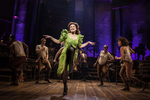Has "actor stays onstage in character during intermission" become more of a thing recently, or is this just a coincidence?
#1Has "actor stays onstage in character during intermission" become more of a thing recently, or is this just a coincidence?
Posted: 8/11/23 at 4:26pm
In the past year, we've seen it in two Robert Icke productions at the Park Ave Armory (Alexandra Hille in Oresteia, Juliet Stevenson in The Doctor) and more famously with Ben Platt in Parade at City Center and Broadway.
I don't recall seeing that happen much prior to this, but three shows indicates a new trend.
What are other older examples of this and have I just missed them?
Musicaldudepeter
Broadway Legend Joined: 3/18/10
#2Has "actor stays onstage in character during intermission" become more of a thing recently, or is this just a coincidence?
Posted: 8/11/23 at 4:42pm
And what is the f@cking point of it? Such a stupid thing to get them to do. No breaks, no rest. As if the audience is wondering WHERE ARE THE ACTORS? when they aren't there during intermission. Awful.
Tsao5
Stand-by Joined: 2/7/06
#3Has "actor stays onstage in character during intermission" become more of a thing recently, or is this just a coincidence?
Posted: 8/11/23 at 4:58pm
As far as I know, Old Deuteronomy in CATS was the only time I have experienced this. I am not exactly sure how union rules work in that, I thought every actor had to have an intermission. However, it never made sense that people could actually go on stage and get an autograph from him. I did that when I was a kid, and the actor playing Old Deuteronomy signed his real name. And there were two stage hands on each side of him. So much for any "illusion". I thought that the whole point of having overgrown set pieces and not seeing the conductor and orchestra was to show a certain size perspective. Years ago on tour, nobody was allowed on stage during intermission....maybe for insurance reasons?
Yessica Haircut
Swing Joined: 7/30/21
#4Has "actor stays onstage in character during intermission" become more of a thing recently, or is this just a coincidence?
Posted: 8/11/23 at 5:34pm
I can't comment as to how often this has happened or if this is some kind of new trend in the theatre. But, as with any aspect of a production, it's all about what the director is trying to say, how that adds to their vision, and how it compliments the overall experience.
With The Doctor, I feel Robert Icke was trying to convey how isolated and stagnant the doctor's life had become after her big decision at the end of the first act. Since the second act begins at least a day following where the first act ended, the image of her sitting at the table and scrolling on her phone as the lights slowly came up (I spent most of intermission in the lobby area, and by the time I got back to my seat she had temporarily gone backstage) made me imagine that, in the time that had passed, that was pretty much what her days had amounted to.
With Parade, I have to imagine it was Michael Arden wanting to highlight the fact that all eyes are now on Leo. Keeping him onstage, watching him mill about his cell like a caged animal, highlights the image of a trapped and unjustly convicted man. Also, to the point above about "No breaks, no rest" - the night I saw the show, a cast or crew member did at least come onstage to give Ben Platt some water.
It definitely wouldn't work all the time, but if used effectively it can add to the experience.
#5Has "actor stays onstage in character during intermission" become more of a thing recently, or is this just a coincidence?
Posted: 8/11/23 at 5:49pm
Yes, I found it extremely effective in the 3 examples I cited and helps the audience remain engaged through intermission.
DJD4
Understudy Joined: 9/17/22
#6Has "actor stays onstage in character during intermission" become more of a thing recently, or is this just a coincidence?
Posted: 8/11/23 at 5:49pm
Yessica Haircut said: "I can't comment as to how often this has happened or if this is some kind of new trend in the theatre. But, as with any aspect of a production, it's all about what the director is trying to say, how that adds to their vision, and how it compliments the overall experience.
WithThe Doctor, I feel Robert Icke was trying to convey how isolated and stagnant the doctor's life had become after her big decision at the end of the first act. Since the second act begins at least a day following where the first act ended, the image of her sitting at the table and scrolling on her phone as the lights slowly came up (I spent most of intermission in the lobby area, and by the time I got back to my seat she had temporarily gone backstage) made me imagine that, in the time that had passed, that was pretty much what her days had amounted to.
WithParade, I have to imagine it was Michael Arden wanting to highlight the fact that all eyes are now on Leo. Keeping him onstage, watching him mill about his cell like a caged animal, highlights the image of a trapped andunjustly convicted man. Also, to the point above about "No breaks, no rest" - the night I saw the show, a cast or crew member did at least come onstage to give Ben Platt some water.
It definitely wouldn't work all the time, but if used effectively it can add to the experience."
From a directing standpoint, I can see why the choice would be made. It certainly helps to maintain the immersion and environment throughout the entire evening. I still can't help but feel like it is kind of gimmicky.
I was in a production of "The Last Days of Judas Iscariot", where the actor playing Judas had to stay onstage in his cell during the entire performance, from house open to the final blackout. The poor actor would run offstage during the blackout so he could go to the bathroom before having to run back on for curtain call. I feel like most of the time the audience just went "oh, he's still there" by the time intermission rolled around.
Dom P
Featured Actor Joined: 7/22/23
#7Has "actor stays onstage in character during intermission" become more of a thing recently, or is this just a coincidence?
Posted: 8/11/23 at 5:51pm
ErmengardeStopSniveling said: "In the past year, we've seen it in two Robert Icke productions at the Park Ave Armory (Alexandra Hille in Oresteia, Juliet Stevenson in The Doctor) and more famously with Ben Platt in Parade at City Center and Broadway.
I don't recall seeing that happen much prior to this, but three shows indicates a new trend.
What are other older examples of this and have I just missed them?"
It seems to me this has occurred in the past, but I can't immediately recall where or when.
#8Has
Posted: 8/11/23 at 6:14pm
Robert Icke's 2015 UK production of The Oresteia (2022 Armory) - and The Doctor beginning in 2019 (2023 Armory) used this concept. He didn't use it for Hamlet. The Oresteia actress was brought water and stayed on stage while the bloody set was cleaned. Stevenson (The Doctor) stays for a bit - leaves - and returns before Act II begins. Characters in turmoil at end of act stay on stage for audience connection to Act 2.
If anything, Michael Arden copied this smart Icke staple for Parade.
Platt, like Icke does for his cast, was brought water. Platt just sat there - in the same way Icke's cast do.His intermission break is during beginning of Act 2 / "Rumbling' & a rollin etc. "
Dom P
Featured Actor Joined: 7/22/23
#9Has
Posted: 8/11/23 at 7:06pm
CoffeeBreak said: "Robert Icke's 2015 UK production of The Oresteia (2022 Armory) - and The Doctor beginning in 2019 (2023 Armory) used this concept. He didn't use it for Hamlet. The Oresteia actress was brought water and stayed on stage while the bloody set was cleaned. Stevenson (The Doctor) stays for a bit - leaves - and returns before Act II begins.
If anything, Michael Ardenstole/copiedthis smart Icke staple for Parade.
Platt, like Icke does for his cast, was brought water. Platt just sat there - in the same way Icke's cast do.His intermission break is during beginning of Act 2 / "Rumbling' & a rollin etc. "
Oh please.
steve.sometime
Stand-by Joined: 12/11/22
#14Has
Posted: 8/11/23 at 9:56pm
To me it seems like an extension of the much larger trend of having actors already onstage when the house opens. Someone above mentioned A Doll's House, but I've seen it dozens of times in the past 6-7 years.
It's gotten to the point where I can actually predict it. Because often, in order to spare the actor, they usually wait to open the house until 10-15 minutes before curtain.
Makes for a great parlor trick with my friends; sometimes I'm with a friend in the lobby at 7:50 or whatever, and I'll say to them: "hey, how much you wanna bet that when we go in the house, there will be 1 or more actors already onstage?" and I've always been right (sometimes they hold the house for other reasons, but I can usually tell the difference beforehand)
BorisTomashevsky
Broadway Star Joined: 4/30/22
#15Has
Posted: 8/11/23 at 10:17pm
I don’t know that the benefit outweighs the cost with stuff like this. I can’t imagine anyone in the audience kept their eyes on Ben Platt for the entire intermission: “Did you see how he moved his elbow? Whaddya think THAT means?!”.
I glanced up, saw the actor-on-stage device happening, felt bad for him, and went back to my Playbill to read about the actors I didn’t know of.
Maybe he enjoyed doing it, but I’d have to imagine most audience members were thinking “Poor guy” and not “What a profound and brilliant idea!”.
#16Has
Posted: 8/11/23 at 11:06pm
Actors remaining onstage in some capacity during "Godspell" has long been a tradition, whether they're doing improv games, handing out juice or other things. The last Godspell I did, we turned the stage into a mini Marie's Crisis during a slightly extended intermission: audience members were invited to come up and have a drink, but also request and sing-along some classic show tunes with a few cast members playing piano or other instruments.
We'd usually end the intermission with a slightly-comic melodramatic performance of "If I Can't Love Her," but closing night, a very large section of the audience joined in on the final chorus, which had never happened before. We decided to add one more song to the intermission that night, and did "Anthem." Nearly the whole audience joined in, and the whole cast came out onstage to sing too. It was one of those magical moments you couldn't recreate.
#17Has
Posted: 8/11/23 at 11:18pm
I have seen it before, once I recall it was at the Atlantic and once on Broadway, but I cannot piece together the shows. In any case, I think it works in the contexts discussed above. It certainly is not being done irrationally. (And no there is no contractual provision.)
I want to say one other thing which is that some here seem to think this is directorial shtick. I can envision situations where the idea originates with the actor, in rehearsal, and I also have seen some actors who do not want to come out of character during the intermission (and that can be challenging backstage). They would welcome it, especially perhaps in an intense play or situation -- such as those mentioned. I think it might seem weirder in some frilly musical.
bowtie7
Stand-by Joined: 7/27/11
#18Has
Posted: 8/12/23 at 11:04am
Not really a new thing. William Goldman in the book The Season describes how Peter Masterson playing the title character in "The Trail of Lee Harvey Oswald" in 1967 was on stage, silent for 2 hours from house open, through the first act, intermission, most of the second act before having his first (and I assume only) line--a 20 minute monologue. As Goldman writes "Masterson was seated on stage as the audience entered, which was someone's literary notion . . . It sounded logical, but it was miserable for the actor. Sitting and staring out at nothing for hours is hard enough, but doing it on a stool when you have a bad back is no help . . . But that wasn't really what made it hard: what really made it hard was the audience at intermission walking up to Masterson and talking to him and about him as he sat there . . . "Hey get him a lemonade somebody" a third one said."
ILoveYourPuppies
Swing Joined: 5/1/23
#20Has
Posted: 8/13/23 at 12:54am
I can only speak to when it was done at Parade, but I thought it was absolutely brilliant.
The whole point of Parade
is that they are putting on a show.
From the first moment of letting Newt Lee go because hanging a Black man wouldn't be sufficient for the crime, to the literal song and dance of the Factory Girls' testimony, to all of the "fun" numbers being the lies about Leo Frank or ignorance of his situation (and when telling the truth or calling for justice in his situation, the mood is killed and/or music stops), to immediately jumping up and celebrating after Leo Frank is convicted, the musical is absolutely clear that the whole "search for justice" is about putting on a show.
By having Ben sit on stage for intermission, the musical refuses to allow the audience to remove themselves. Ordinary intermission has the lights come up and people get up, go to the bathroom, talk, do their thing. They are no longer in the magic of the show. But not now. Now, a man has been sentenced to death and is right in front of you. And you can't get close a curtain on him and get 15 minutes of peace - you are forced to be part of the musical. You don't get to ignore the miscarriage of justice for 15 minutes and then resume the musical after a break. You have to live in it, just like he did.
You're forced to be part of the spectacle. You don't speak up and save him. You have three possible reactions: 1. You simply watch him wait for his death for a crime he didn't commit, 2. Go about your daily life ignoring the innocent man in front of you, 3. or, worst of all, you take advantage of the innocent man who's been wrongfully convicted (the people taking pictures at the show and/or enjoying the acting, taking pleasure out of a negative situation).
I have rarely felt more uncomfortable than I did at Parade intermission. It was a brilliant choice.
Penna2
Broadway Star Joined: 2/24/18
#22Has
Posted: 8/13/23 at 6:26pm
Not relation to a play, but the only time I ever saw a performer stay on stage during an intermission wasn't a play, but a concert...Dick Shawn literally lay down on and took a "nap." Several years later, he actually had a heart attack and died during one of his shows. The audience thought it was part of the act.
Updated On: 8/13/23 at 06:26 PM#24Has
Posted: 8/13/23 at 8:41pm
There are some productions where it works, and some where it doesn't, just like any other theatrical conceit.
The most effective use I've seen wasn't intermission, but it was preshow. This was Hedda Gabler at the Public with Elizabeth Marvel. If you didn't see this production, it was done with a stage up front and a walkway surrounding the audience. Cast members could enter and exit from the back of the house. The audience was basically trapped inside with Hedda. Marvel sat onstage, slumped over a piano, occasionally playing some notes as timed ticked by in another day of her life. The house went down but the theatre never fully went dark as the walkway was always lit.
There were some big swings in that production that didn't land for me, but I found the actor onstage before the show conceit to work here.
#25Has
Posted: 8/13/23 at 9:44pm
trentsketch said: "There are some productions where it works, and some where it doesn't, just like any other theatrical conceit.
The most effective use I've seen wasn't intermission, but it was preshow. This was Hedda Gabler at the Public with Elizabeth Marvel. If you didn't see this production, it was done with a stage up front and a walkway surrounding the audience. Cast members could enter and exit from the back of the house. The audience was basically trapped inside with Hedda. Marvel sat onstage, slumped over a piano, occasionally playing some notes as timed ticked by in another day of her life. The house went down but the theatre never fully went dark as the walkway was always lit.
There were some big swings in that production that didn't land for me, but I found the actor onstage before the show conceit to work here."
^That production was at NYTW, I believe - and for those wondering, it was an Ivo Van Hove joint. He did it again with Ruth Wilson in London, which I saw. I believe it was a similar set, and they did the same thing with her at the piano, though there was no walkway (it was at the Lyttelton, which is quite a bit larger than NYTW). Sounds like a cool additional element to the conceit, though!







.jpg)